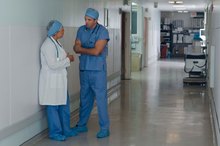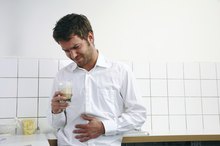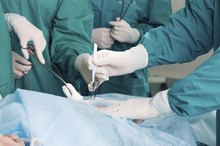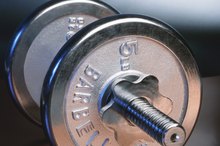Symptoms of Inguinal Hernia Pain From a Bicycle
A hernia is a protuberance of the intestines through a hole in your abdominal wall. A hernia that affects your groin is called an inguinal hernia 1. Inguinal hernias may be caused by a birth defect, or may develop later in life as a result of increased intra-abdominal pressure from lifting heavy objects, muscle strains, excess abdominal weight, straining during bowel movements and pregnancy. Hernias are classified into three types: reducible, incarcerated or strangulated. The symptoms you may experience from riding a bicycle depend on the type of inguinal hernia present 1.
Reducible Inguinal Hernia
A reducible hernia is one that can be pushed back into the abdomen. A bulge in the groin or scrotum may or may not be present, depending on the size of the hernia. Reducible hernias tend to get larger in size while standing or straining, and smaller while lying down, according to the Milton S. Hershey Medical Center 3. Some individuals may experience no pain, while others experience pressure or pain that is only evident while lifting heavy objects or straining. A burning or “gurgling” sensation may also be present at the site of the hernia.
- A reducible hernia is one that can be pushed back into the abdomen.
- Reducible hernias tend to get larger in size while standing or straining, and smaller while lying down, according to the Milton S. Hershey Medical Center 3.
Incarcerated Inguinal Hernia
Hernia Signs and Symptoms in a Male
Learn More
Hernias that cannot be reduced back into the abdomen are referred to as irreducible or incarcerated, and occur when the intestines are caught within the inguinal canal. You'll often notice an apparent bulge in the groin while both standing and lying down. Incarcerated hernias can lead to obstruction of the bowel, which manifests as groin pain, nausea and vomiting. An incarcerated hernia is a dangerous condition, so if you suspect you have it, see a doctor immediately.
- Hernias that cannot be reduced back into the abdomen are referred to as irreducible or incarcerated, and occur when the intestines are caught within the inguinal canal.
- An incarcerated hernia is a dangerous condition, so if you suspect you have it, see a doctor immediately.
Strangulated Inguinal Hernia
When the blood supply to an incarcerated hernia becomes cut off for some time, the portion of the intestines that is caught within the groin dies -- this is known as a strangulated inguinal hernia 1. Strangulated hernias symptoms include a worsening pain that comes on suddenly, fever, fast heartbeat and a red to purple discoloration of the hernia.
Warning
Hernia Symptoms for Women
Learn More
Make an appointment with your healthcare provider if you notice pain or a bulge in your groin or scrotum. Although surgery is not necessary for reducible hernias, many people choose to have them repaired surgically to avert the risk of strangulation. Immediate surgical repair, however, is required for incarcerated and strangulated hernias. Seek medical attention immediately if you have symptoms of either one of these conditions.
- Make an appointment with your healthcare provider if you notice pain or a bulge in your groin or scrotum.
- Although surgery is not necessary for reducible hernias, many people choose to have them repaired surgically to avert the risk of strangulation.
Related Articles
References
- Mayo Clinic: Inguinal Hernia
- Penn State Milton S. Hershey Medical Center: Inguinal Hernia
- Yoong P, Duffy S, Marshall TJ. The inguinal and femoral canals: A practical step-by-step approach to accurate sonographic assessment. Indian J Radiol Imaging. 2013;23(4):391–395. doi:10.4103/0971-3026.125586
- Harvard Health Publishing. Inguinal hernia. Updated July 2019.
- Lee SS, Jung HJ, Park BS, Son GM, Cho YH. Surgical Aspects of Recurrent Inguinal Hernia in Adults. Am Surg. 2016;82(11):1063–1067.
- Wang KS. Assessment and management of inguinal hernia in infants. Pediatrics. 2012;130(4):768-73. doi:10.1542/peds.2012-2008
- University of California San Francisco General Surgery. Inguinal hernia.
- National Institute of Diabetes and Digestive and Kidney Diseases. Inguinal hernia. Updated September 2019.
- Kulacoglu H. Current options in inguinal hernia repair in adult patients. Hippokratia. 2011;15(3):223–231.
- National Health Services. Inguinal hernia repair recovery. Updated June 14, 2018.
- Hernia. National Institutes of Health.
Resources
Writer Bio
Kimberly Rienecke started her career as a health and fitness writer by working for various websites. She is a certified orthopedic physician assistant and an ACE-certified personal trainer. She also holds a Bachelor of Science in biology from Towson University.








